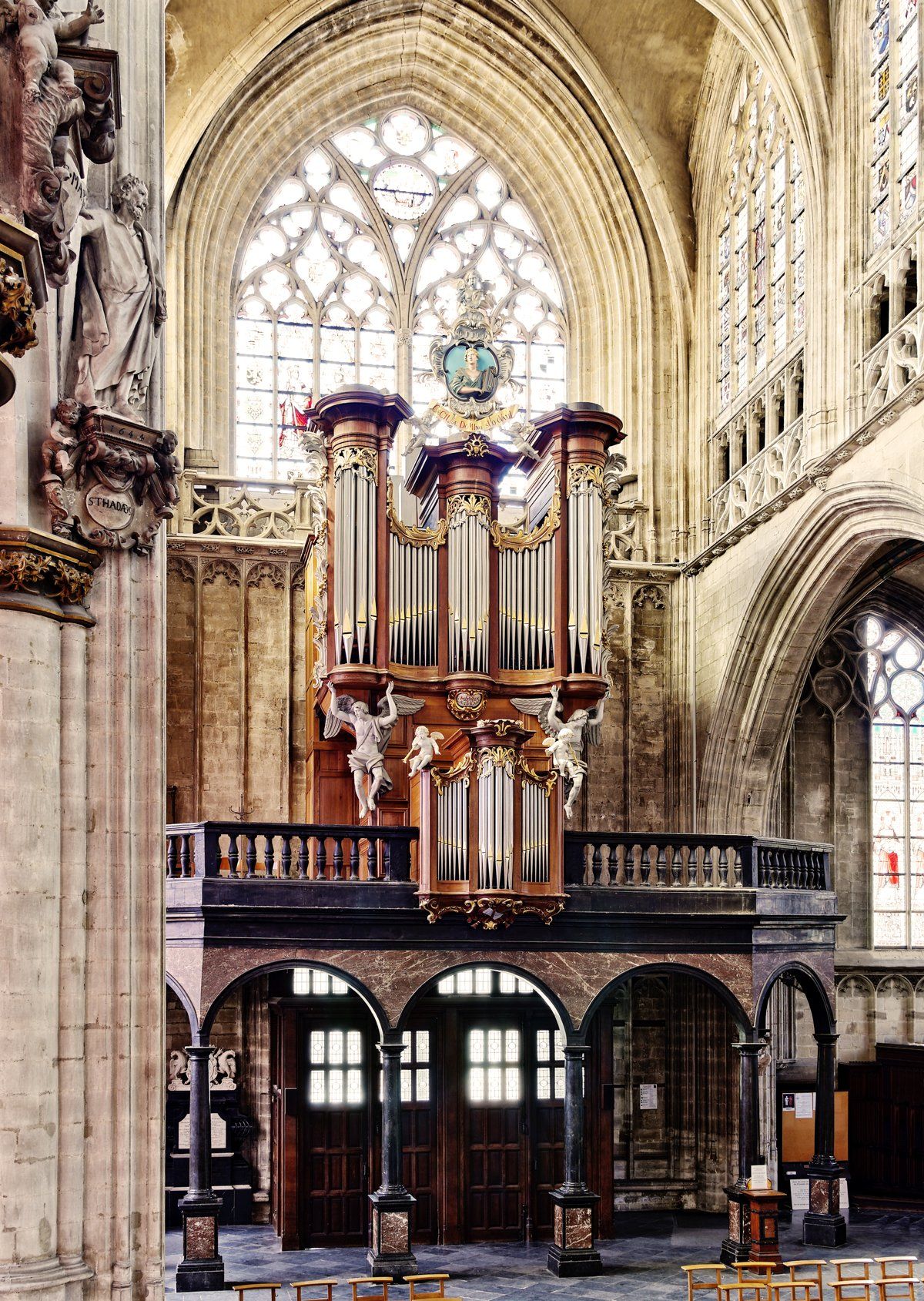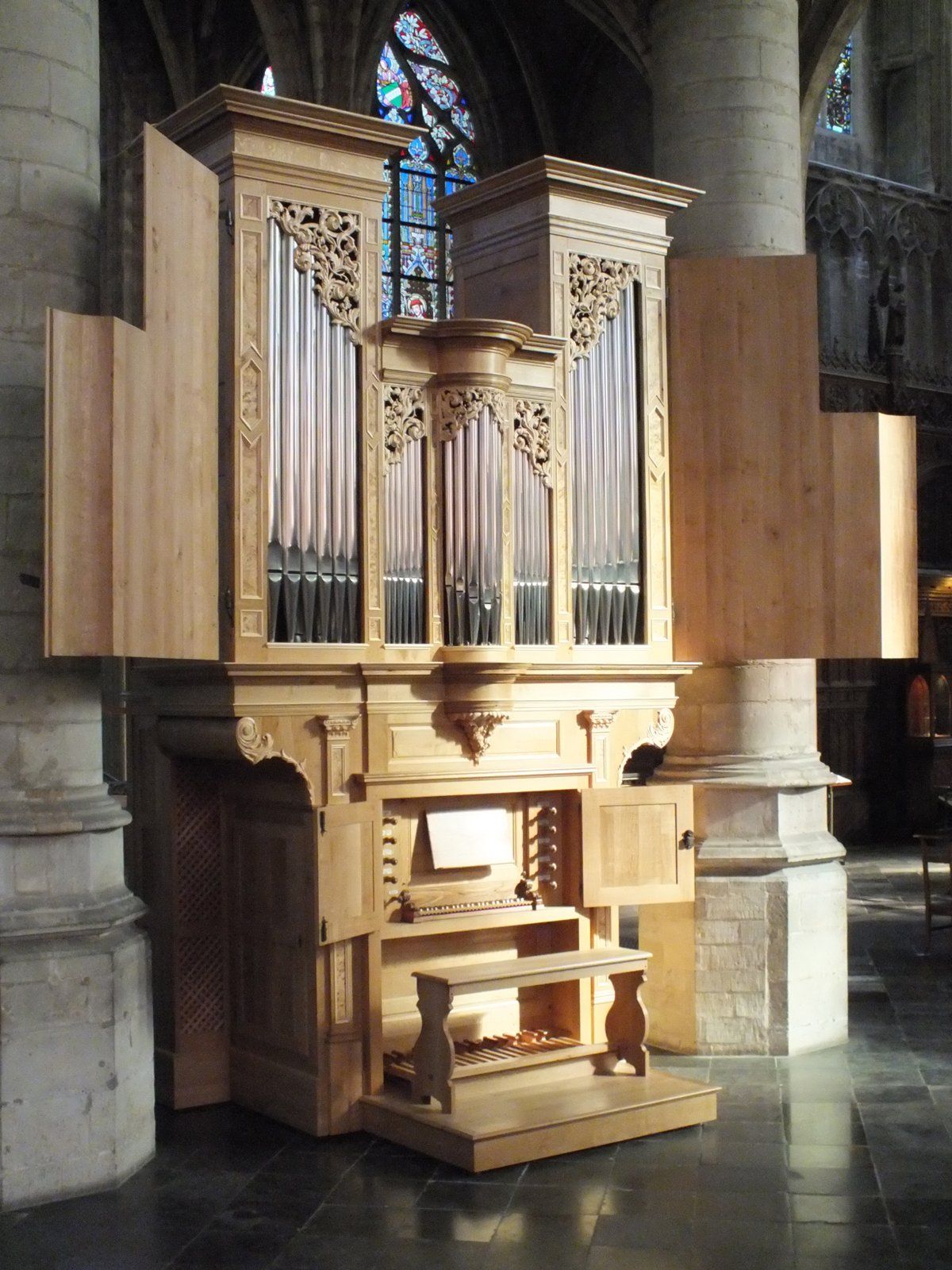Organ directory
Our Lady of Sablon church
Jean-Baptiste Bernabé Goynaut 1763 Great Organ – Westenfelder 1989
In 1763, Jean-Baptiste Bernabé Goynaut built the organ for the Notre-Dame au Sablon church, in an organ case made by carpenter Jean Van Gelder. The organ builder was born in Condé (France) around 1725. He had been the apprentice of the weel-known Brussels craftsman Forceville, whose workshop he overtook around 1750. Nowadays, most of the organs built by Goynaut have disappeared. One can however see in the Notre-Dame church of Vilvoorde, an organ case very similar to that of the Sablon.
In 1893, organ-builder Pierre Schyven completely remodelled the instrument, keeping however the case which he declared was "not devoid of artistic value". Later, organ builders Vermeersch (1870), Kerkhoff (in the 1920's) and Boeckx (1935) worked int the instrument, but did not modify it so fundamentally.
The rebuild of 1989
Peter Culver, the general manager of Euro-clear Operations Centre, launched a sponsorship involving J. P. Morgan Belgium which led to a fundamental reconstruction of the organ in 1989. It was executed by Georg Westenfelder following a project designed by Jean Ferrard, of which the philosophy was such: the Sablon is the only eighteenth century organ case extant in Brussels; on the other hand, the instrument placed behind this case by Pierre Schyven did not sound too well there, and there are still a few realizations by this organ builder in the city, which are more interesting (the church of la Chapelle or Saint-Jacques, both not far away).
Therefore, it was decided to make a reconstitution of the whole case, and to place in it an instrument inspired by its original style, that of Brussels organ-building of the eighteenth century. An independent pedal division was discretely placed behind the old case, in order to enlarge the repertory possibilities offered by the organ.
Disposition
| I. POSITIF (54 notes) | II. GRAND-ORGUE (54 notes) | III. ECHO (54 notes) (actives de c à f’’’) | PÉDALE (30 notes) |
|---|---|---|---|
| Bourdon 8 | Bourdon 16 | Bourdon 8 | Flûte 16 |
| Prestant 4 | Montre 8 | Prestant 4 | Flûte 8 |
| Flûte 4 | Bourdon 8 | Doublette 2 | Flûte 4 |
| Doublette 2 | Prestant 4 | Nasard 2 2/3 | Flûte 2 |
| Nasard 2 2/3 | Flûte 4 | Tierce 1 3/5 | Bombarde 16 |
| Tierce 1 3/5 | Doublette 2 | Trompette 8 | Trompette 8 |
| Larigot 1 1/3 | Grosse tierce 3 1/5 | Trémolo | Clairon 4 |
| Fourniture III | Nasard 2 2/3 | Tremblant Grand-Orgue et Echo | |
| Cymbale II | Tierce 1 3/5 | ||
| Cornet III | Sesquialtera II B + D | ||
| Cromorne 8 B + D | Fourniture IV | ||
| Trémolo | Cymbale III | ||
| Tremblant | Cornet V | ||
| Bombarde 16 | |||
| Trompette 8 B + D | |||
| Clairon 4 | |||
| Voix humaine 8 B +D | |||
| Accouplements et tirasses | Accouplements | ||
| Positif / Grand-Orgue par tiroir | Grand-Orgue/Pédale | ||
| Trémolo | Positif/Pédale | ||
| Tremblant Grand-Orgue et Echo |
Rudi Jacques 2011 Choir Organ
In recent years, and especially since the restoration of the exterior of the church, the organists of Notre-Dame au Sablon, Benoît Mernier, Roland Servais and Arnaud Van de Cauter gave a new impulse to the musical activities in the church, be it for concerts as well as liturgy. Since then, professional choirs or solo singers and instrumentalists enhance the celebrations. To improve their work environment and insure a closer relation with the public, it was decided to build a second organ. This new instrument will be more suitable for some other musical repertoires than those until now performed on the Goynaut-Westenfelder organ on the west-end gallery. The aesthetics of this new instrument is related to the German Baroque, but the choice of a temperament more equal than that of the gallery organ will contribute to the extension of its possibilities. In order to find the best acoustical location for the organ, several trials led to the conclusion that two places were optimal: behind the main altar or where the new organ now stands. The need for visibility led to the present location, between two pillars of the main nave.
The proportions of the case are inspired by a few Austrian organs, in particular that of Maienfeld. It is made of oak, lime was used for the carvings, inlays are veneered with elm, keyboards are made of boxwood and ebony, the keyboard cheeks and the register knobs are made of walnut. In the pipe shades of the tower, the wood-carver represented the boat, emblematic of the church. The pipes are hand-made, the tin foil (90% tin for the principals, 25 % for the flutes) was cast, planed, hammered and soldered in the organ builder's workshop. The scales are inspired by Lorentz's pipework in the organ of the cathedral in Roskilde (1654).
Disposition
| Principal 8 |
| Gedackt 8 |
| Praestant 4 |
| Rohr Flöte 4 |
| Octava 2 |
| Mixtur IV |
| Sexquialtera II B + D |
| Pédale |
| Subbass 16 |
| Tirasse |
| Tremblant |




